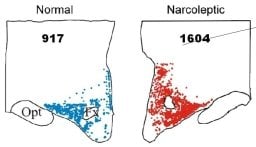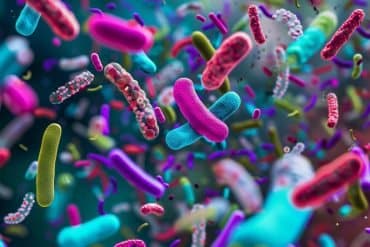In 2000, researchers at the UCLA Center for Sleep Research published findings showing that people suffering from narcolepsy, a disorder characterized by uncontrollable periods of deep sleep, had 90 percent fewer neurons containing the neuropeptide hypocretin in their brains than healthy people. The study was the first to show a possible biological cause of the disorder.
Subsequent work by this group and others demonstrated that hypocretin is an arousing chemical that keeps us awake and elevates both mood and alertness; the death of hypocretin cells, the researchers said, helps explain the sleepiness of narcolepsy. But it has remained unclear what kills these cells.
Now the same UCLA team reports that an excess of another brain cell type — this one containing histamine — may be the cause of the loss of hypocretin cells in human narcoleptics.
UCLA professor of psychiatry Jerome Siegel and colleagues report in the current online edition of the journal Annals of Neurology that people with the disorder have nearly 65 percent more brain cells containing the chemical histamine. Their research suggests that this excess of histamine cells causes the loss of hypocretin cells in human narcoleptics.

Narcolepsy is a chronic disorder of the central nervous system characterized by the brain’s inability to control sleep–wake cycles. It causes sudden bouts of sleep and is often accompanied by cataplexy, an abrupt loss of voluntary muscle tone that can cause person to collapse. According to the National Institutes of Health, narcolepsy is thought to affect roughly one in every 3,000 Americans. Currently, there is no cure.
Histamine is a body chemical that works as part of the immune system to kill invading cells. When the immune system goes awry, histamine can act on a person’s eyes, nose, throat, lungs, skin or gastrointestinal tract, causing the symptoms of allergy that many people are familiar with. But histamine is also present in a type of brain cell.
For the study, researchers examined five narcoleptic brains and seven control brains from human cadavers. Prior to death, all the narcoleptics had been diagnosed by a sleep disorder center as having narcolepsy with cataplexy. These brains were also compared with the brains of three narcoleptic mouse models and to the brains of narcoleptic dogs.
The researchers found that the humans with narcolepsy had an average of 64 percent more histamine neurons. Interestingly, the team did not see an increased number of these cells in any of the animal models of narcolepsy.
“Humans and animals with narcolepsy share the same symptoms, but we did not see the histamine cell changes we saw in humans in the animal models we examined,” said Siegel, who directs the Center for Sleep Research at the UCLA Semel Institute for Neuroscience and Human Behavior and is the senior author of the research. “We know that narcolepsy in the animal models is caused by engineered genetic changes that block hypocretin function. However, in humans, we did not know why the hypocretin cells die.
“Our current findings indicate that the increase of histamine cells that we see in human narcolepsy may cause the loss of hypocretin cells,” he said.
The study results may also further our understanding of brain plasticity, Siegel noted. While scientists have known of the existence neurogenesis — the process by which the brain is populated with new neurons — it was thought to function mainly to replace existing cells that had died.
“This paper shows for the first time that neuronal numbers can increase greatly and not just serve as replacement cells,” he said. “In the current example, this appears to be pathological with the destruction of hypocretin, but in other circumstances, it may underlie recovery and learning and open new routes to treatment of a number of neurological disorders.”
Notes about this neurology and narcolepsy research
Siegel is also the chief of neurobiology research at the Sepulveda Veterans Affairs Medical Center in Mission Hills, Calif. Other authors on the study included co–first authors Joshi John and Thomas C. Thannickal, Ronald McGregor, Lalini Ramanathan and Carly Stone of UCLA; Marcia Cornford of Harbor–UCLA Medical Center; Hiroshi Ohtsu of Japan’s Tohoku University; Seiji Nishino and Noriaki Sakai of Stanford University; and Akhiro Yamanaka of Japan’s Nagoya University.
Funding for the study was provided by the Medical Research Service of the U.S. Department of Veterans Affairs and by National Institutes of Health grants NS14610 and MH064109.
Contact: Mark Wheeler – UCLA
Source: UCLA press release
Image Source: The hypothalamus and histamine cell image is credited to Jerome Siegel, UCLA. The image is adapted from the press release.
Original Research: Abstract for “Greatly increased numbers of histamine cells in human narcolepsy with cataplexy” by Joshi John, Thomas C. Thannickal, Ronald McGregor, Lalini Ramanathan, Hiroshi Ohtsu, Seiji Nishino, Noriaki Sakai, Akhiro Yamanaka, Carly Stone, Marcia Cornford and Jerome M. Siegel in Annals of Neurology. Published online July 2 2013 DOI: 10.1002/ana.23968






